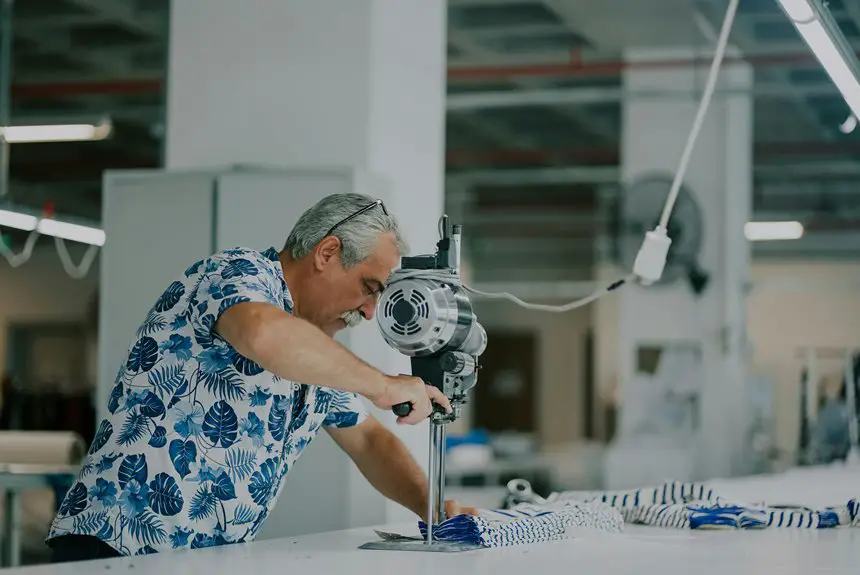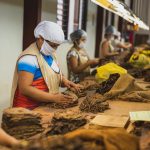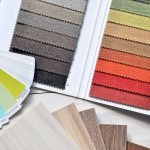You’ll find that nonwoven fabrics come from several key methods: spunbond melts polymers into continuous fibers for strong, lightweight webs; meltblown uses high-velocity air to make fine filtration fibers; needle punching mechanically entangles fibers for durability; and hydroentanglement employs water jets to create soft, flexible fabrics without chemicals. Each method shapes fabric properties for specific uses, whether masks, wipes, or geotextiles. Keep exploring to understand how these processes impact fabric performance and applications.
Table of Contents
Key Takeaways
- Spunbond production melts polymer chips, extrudes continuous fibers, and bonds webs thermally or mechanically for strong, breathable fabrics.
- Meltblown uses high-velocity hot air to create superfine fibers, forming soft webs ideal for filtration and masks.
- Needle punching mechanically entangles fibers with barbed needles, producing thick, durable fabrics without adhesives or heat.
- Hydroentanglement employs high-pressure water jets to tangle fibers, creating soft, flexible fabrics without chemical binders.
- Chemical bonding applies adhesives to webs, controlling fabric properties by binder type and application amount.
What Are Nonwoven Fabrics?
Nonwoven fabrics are materials made by bonding or interlocking fibers through mechanical, chemical, or thermal processes instead of weaving or knitting.
When you work with nonwoven fabrics, you’ll notice they offer unique properties like flexibility, durability, and breathability.
These fabrics don’t rely on traditional thread patterns; instead, fibers are laid randomly or oriented in specific directions to achieve desired characteristics.
You’ll find nonwovens in everyday items such as filters, medical masks, and disposable wipes because they balance strength and softness efficiently.
Understanding what nonwoven fabrics are helps you appreciate how versatile and innovative these materials can be.
They’re designed to meet specific needs without the complexity of traditional textile manufacturing, making them cost-effective and adaptable for many applications.
Spunbond Nonwoven Fabric Production Process
The spunbond process creates fabric by melting polymer chips and extruding them into continuous filaments. You’ll see these filaments laid down onto a conveyor belt, forming a web. Then, the web is bonded through thermal or mechanical methods to give the fabric strength and durability. This approach produces lightweight, strong, and breathable nonwoven fabrics, ideal for applications like medical masks and geotextiles.
| Step | Description |
|---|---|
| Polymer Melting | Chips are melted into a liquid form |
| Filament Extrusion | Continuous fibers are spun out |
| Web Formation & Bonding | Fibers form a web and get bonded |
Meltblown Nonwoven Fabric Production Process
Meltblown fabric production relies on forcing molten polymer through tiny nozzles using high-velocity hot air, creating superfine fibers. As the polymer exits, the hot air stretches these fibers to diameters as small as one micron, much thinner than those in spunbond fabrics.
You collect these fibers on a moving conveyor belt, where they cool and bond into a soft, breathable web. This process gives meltblown fabrics unique filtration properties, making them ideal for masks, filters, and absorbent products.
You’ll notice that controlling air pressure and polymer temperature is essential to guarantee consistent fiber diameter and fabric quality.
Unlike spunbond, meltblown fibers are shorter and more randomly oriented, which enhances filtration efficiency but reduces tensile strength. This method prioritizes fine fiber production for specialized applications.
Needle Punching Technique for Nonwovens
Needle punching uses thousands of barbed needles to mechanically entangle fibers, creating a strong, durable fabric without adhesives or heat. You guide fiber webs under needles repeatedly, bonding them into a cohesive nonwoven. This method suits applications needing thickness and robustness, like geotextiles or automotive interiors. You can adjust needle density and penetration depth to control fabric density and strength.
Here’s a quick comparison of needle punching features:
| Aspect | Description | Effect on Fabric |
|---|---|---|
| Needle Density | Needles per square inch | Higher = stronger fabric |
| Penetration Depth | How deep needles penetrate fibers | Deeper = denser texture |
| Fiber Type | Natural or synthetic fibers | Affects durability and feel |
This technique gives you flexibility and strength without chemical binders.
Hydroentanglement Method Explained
Hydroentanglement uses high-pressure water jets to tangle fibers into a strong, cohesive fabric without chemicals or binders.
High-pressure water jets intertwine fibers into strong, cohesive fabrics without any chemicals or binders.
When you use this method, water jets shoot at the fiber web, forcing the fibers to intertwine tightly. This mechanical action creates a fabric that’s soft, durable, and flexible, perfect for wipes, medical textiles, and hygiene products.
You can control the fabric’s density and texture by adjusting the water pressure and jet pattern. Unlike other methods, hydroentanglement doesn’t weaken the fibers since it avoids harsh chemicals or needles.
So, if you want a clean, environmentally friendly process that produces a breathable, cloth-like material, hydroentanglement is a smart choice.
It’s efficient, versatile, and produces high-quality nonwoven fabrics ideal for many applications.
Chemical Bonding in Nonwoven Fabric Manufacturing
While hydroentanglement relies on mechanical forces to bind fibers, chemical bonding uses adhesives or binders to hold the fibers together. This method lets you control fabric properties by adjusting the type and amount of binder applied. You’ll find chemical bonding ideal for producing fabrics with enhanced strength, durability, and resistance to liquids.
Here’s a quick breakdown of key binders used in chemical bonding:
| Binder Type | Characteristics | Common Applications |
|---|---|---|
| Latex | Flexible, water-resistant | Medical, wipes |
| Polyvinyl Alcohol | Water-soluble, strong | Hygiene products |
| Acrylic | Durable, UV-resistant | Outdoor fabrics |
| Polyurethane | Elastic, abrasion-resistant | Apparel linings |
| Epoxy | Rigid, heat-resistant | Industrial filters |
Chemical bonding offers versatility, letting you tailor the fabric’s performance to your needs.
Thermal Bonding Process for Nonwoven Fabrics
Thermal bonding uses heat to fuse fibers together, creating strong and durable nonwoven fabrics without the need for adhesives.
When you use this process, you apply controlled heat and pressure to thermoplastic fibers, causing them to melt slightly and bond at contact points. This method is efficient and clean since it avoids chemicals, making it ideal for hygienic products like wipes and medical textiles.
You can choose between through-air bonding or calendar bonding, depending on your fabric’s texture and strength requirements. Through-air bonding passes hot air through the web, while calendar bonding uses heated rollers.
Airlaid Nonwoven Fabric Production Steps
Because airlaid nonwoven fabric relies on a unique fiber deposition method, you’ll find its production steps distinct from other processes.
First, fibers are loosened and separated using air streams, creating a fluffy, uniform fiber web.
Next, you allow these fibers to deposit randomly onto a moving conveyor belt, forming the basic fabric structure.
After this, you apply binders or adhesives, either by spraying or printing, to hold the fibers together.
Then, you cure the fabric through heating to activate the binder and solidify the web.
Finally, you cool and wind the finished fabric for further processing or use.
This method gives you a soft, absorbent, and bulky fabric ideal for hygiene and absorbent products.
Wetlaid Nonwoven Fabric Formation
Now, you’ll see how wetlaid nonwoven fabrics start with a fiber suspension process, where fibers are dispersed in water.
Then, web formation techniques move the fibers into a uniform layer. This method is key to creating strong, even fabrics.
Fiber Suspension Process
Although you might be familiar with dry fiber methods, the fiber suspension process offers a unique way to create nonwoven fabrics by dispersing fibers in water before forming a web. You start by suspending fibers in water, ensuring even distribution. This wetlaid method helps produce uniform, lightweight fabrics ideal for hygiene products and filters.
Here’s how the process breaks down:
| Step | Description | Purpose |
|---|---|---|
| Fiber Dispersion | Fibers mixed with water | Achieve uniform suspension |
| Web Formation | Fibers deposited onto screen | Create a wet fiber mat |
| Water Removal | Drainage and pressing | Consolidate fibers |
| Drying | Heat application | Finalize fabric structure |
Web Formation Techniques
After suspending fibers evenly in water, the next step involves forming them into a web, which shapes the fabric’s structure and properties.
In wetlaid nonwoven fabric formation, you spread this fiber suspension onto a moving screen or wire mesh. As water drains through, the fibers settle and interlock, creating a uniform web.
Controlling the fiber concentration, flow rate, and drainage speed lets you tailor the web’s density and thickness.
Once the web forms, you transfer it to pressing or drying stages to remove excess moisture and bond fibers. This wetlaid process mirrors papermaking, giving you excellent control over fiber orientation and fabric uniformity.
Applications of Different Nonwoven Production Methods
When you explore nonwoven fabric production methods, you’ll find each technique suits specific applications based on factors like strength, softness, and cost.
For example, spunbond fabrics are great for durable items like reusable shopping bags and automotive interiors because they provide strength and resistance.
Spunbond fabrics offer durability and resistance, ideal for reusable bags and automotive interiors.
Meltblown fabrics, with their fine fibers, work well in filtration products such as face masks and air filters.
Needle-punched nonwovens offer excellent cushioning, making them ideal for geotextiles and carpet backing.
Hydroentangled (spunlace) fabrics feel soft and absorbent, perfect for medical wipes and hygiene products.
Comparing Strength and Properties of Nonwoven Fabrics
Understanding the applications of various nonwoven production methods helps highlight why their strength and other properties matter.
When you compare spunbond, meltblown, and needle-punched fabrics, you’ll see each offers distinct benefits. Spunbond fabrics provide excellent tensile strength, making them ideal for reusable items. Meltblown fabrics, though weaker, excel in filtration due to their fine fiber structure.
Needle-punched nonwovens deliver high durability and thickness, perfect for geotextiles and automotive uses. You’ll also notice differences in softness, permeability, and absorbency depending on the method used.
Frequently Asked Questions
What Are the Environmental Impacts of Nonwoven Fabric Production?
You’ll find that nonwoven fabric production can use lots of energy and water, and sometimes releases pollutants. But if you choose recycled or biodegradable materials, you can reduce its environmental footprint considerably.
How Is Quality Control Maintained in Nonwoven Fabric Manufacturing?
You maintain quality control by regularly testing fabric strength, thickness, and uniformity. Automated inspections catch defects early, while continuous monitoring guarantees consistent production standards, helping you deliver reliable, high-quality nonwoven fabrics every time.
What Are the Common Additives Used in Nonwoven Fabric Production?
When you spot a soft, durable nonwoven fabric, chances are it’s because additives like binders, flame retardants, and antimicrobial agents were mixed in. They boost strength, safety, and freshness, making the fabric perform just right.
How Do Nonwoven Fabric Production Costs Compare Across Methods?
You’ll find spunbond methods generally cost less due to continuous production, while needle-punching and hydroentangling can be pricier because of labor and equipment. Costs vary based on materials, scale, and desired fabric properties.
What Innovations Are Emerging in Nonwoven Fabric Technologies?
You might think innovations only tweak existing methods, but new tech like bio-based fibers, smart textiles, and energy-efficient processes are transforming nonwoven fabrics. You’ll see improved sustainability, functionality, and cost-effectiveness shaping the industry’s future.
- Nonwoven Fabric for Masks: What Makes a Good Filter? - July 11, 2025
- A Practical Guide to Using Nonwoven Geotextiles - July 11, 2025
- Everything You Should Know About Nonwoven Wallpaper - July 11, 2025







